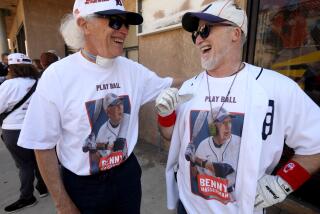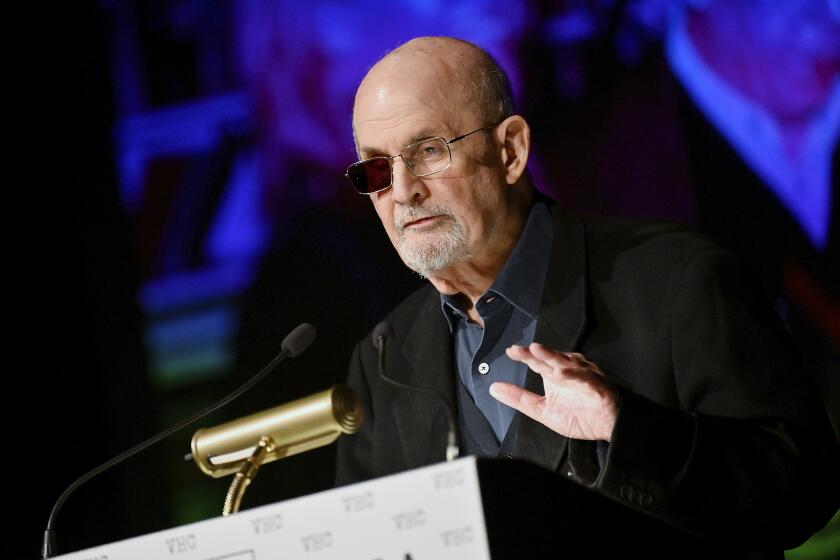‘Fifty-nine in ‘84’ by Edward Achorn
He was the greatest pitcher no one’s ever heard of: Old Hoss Radbourn, star of the Providence Grays. Back in organized baseball’s infancy, he won 309 games in just 11 major league seasons and led his team to the 1884 National League pennant.
But more significant than the Grays’ success that year was what Radbourn achieved as an individual. As Edward Achorn recounts in “Fifty-nine in ‘84: Old Hoss Radbourn, Barehanded Baseball, and the Greatest Season a Pitcher Ever Had,” Radbourn won 59 games in 1884 -- a mark that has never come close to being broken.
“In 1916,” Achorn writes, “a baseball writer named Brown Holmes polled ten famous major-league managers, asking them to choose the greatest feat in the game’s history. . . . When it came time to cast their votes . . . six of the ten managers, including some of the keenest minds in the game -- John McGraw, Connie Mack, Pat Moran, Clark Griffith, Jimmy Callahan, and Hugh Jennings -- picked . . . Radbourn’s astonishing performance in 1884.”
It’s tempting to dismiss the feats of early baseball; in the 19th century, the game existed in protean form. In 1887, an outfielder named Tip O’Neill batted .492 for the season, but this was at a time when walks counted as hits. Yet, Achorn makes clear, Radbourn’s pitching record was legitimate and hard-earned. “[A] team’s top pitcher,” he explains, “needed unyielding stamina -- mental as well as physical -- to survive, throwing day after day.” In one evocative passage, he describes what Radbourn faced during the 1884 stretch run: “The punishing repetition -- pitch after pitch after pitch, day after day, without significant rest -- had surely started to wear down his rotator cuff. . . . Even after the pain had set in, searing his shoulder, jarring him awake several times a night, he had continued to pitch.”
In the 1880s, most teams carried only two starting pitchers; for the Grays, this led to a crisis when, in late July, 21-year-old phenom Charlie Sweeney, who had outpitched Radbourn over the first part of the season, was expelled from the team -- and the National League -- for insubordination. From that point on, the burden was on Radbourn, who started 41 of the team’s final 51 games. The pace was unyielding, even by the standards of 19th century baseball, but Radbourn faced it with stolid grace. For Achorn, he is an American archetype: the son of a butcher for whom pitching offered a better life:
“During the 1884 season,” he writes, “a man approached the great pitcher in a hotel lobby. ‘Gee, Old Hoss, ain’t you ever going to tire out?’ he asked. ‘Tire out?’ Radbourn snapped at him. ‘Tire out tossing a little five-ounce ball for two hours a day? Man, I used to be a butcher. From 4 in the morning until 8 at night I knocked down steers with a 25-pound sledge. Tired of playing 2 hours a day for 10 times the money I got for 16 hours a day?’ This was not a complaint: just an acknowledgment that life was hard and that men were supposed to shut up and bear it.”
Such an attitude, Achorn suggests, was essential not only to Radbourn’s success on the ball field but also to his survival. America in the 1880s was a rough-and-tumble place where “[c]rime flourished, not only in the dark alleys and red-light districts, but also in the nation’s city halls and capitol buildings.” Providence, R.I., a small city 35 miles southeast of Boston, offered a microcosm of the larger culture: Because it was a rail hub, it became, one observer noted, “a rendezvous of the wayward,” where people “who seek facile pleasures” inevitably stopped to spend time.
Achorn writes with relish about this history of dissolution; the deputy editorial page editor of the Providence Journal, he loves the toughness of the place. This translates to his account of Radbourn’s legendary season, and the rigors of the early game.
Indeed, the most vivid aspect of “Fifty-nine in ‘84” is its meticulous re-creation of the 1884 season, inning-by-inning, game-by-game. We’re used to this in terms of contemporary baseball, which we can relive, almost as soon as we have seen it, on Web videos and DVDS. But the 19th century remains a kind of dead zone, the dark age of the sport.
Even the names we recognize -- Cap Anson, John M. Ward, Tim Keefe -- are, for us, less men than monuments, as stiff and unmoving as the rigidly posed photos of their tobacco trading cards. Achorn’s book reproduces many of those photos, including one of Radbourn subtly positioning his hand to give the finger to the world.
But it’s the vibrancy of his story that resonates, the sense of Radbourn and these others not as historical figures but as human beings. The game they played was brutal, with no gloves or protective gear, and no substitutions except in the case of catastrophic injury. In such a context, Radbourn’s 59 wins became even more unlikely, although perhaps most astounding are the nearly 680 innings he threw. (By contrast, the Detroit Tigers’ Justin Verlander led the major leagues with 240 innings pitched in 2009.)
In baseball, as in anything, it’s a fool’s game to compare eras; the challenges of one don’t necessarily tell us anything about the next. But even by the standards of his moment, Radbourn’s 1884 performance was off the charts.
“Radbourn has made a record which will probably never be equaled in the history of base ball,” noted the Boston Globe. “He has fulfilled his promise and has the satisfaction of knowing that he has done what probably no other man in the world could do.” With “Fifty-nine in ‘84,” Achorn returns this remarkable season -- and this remarkable pitcher -- to something close to life.
More to Read
Sign up for our Book Club newsletter
Get the latest news, events and more from the Los Angeles Times Book Club, and help us get L.A. reading and talking.
You may occasionally receive promotional content from the Los Angeles Times.







